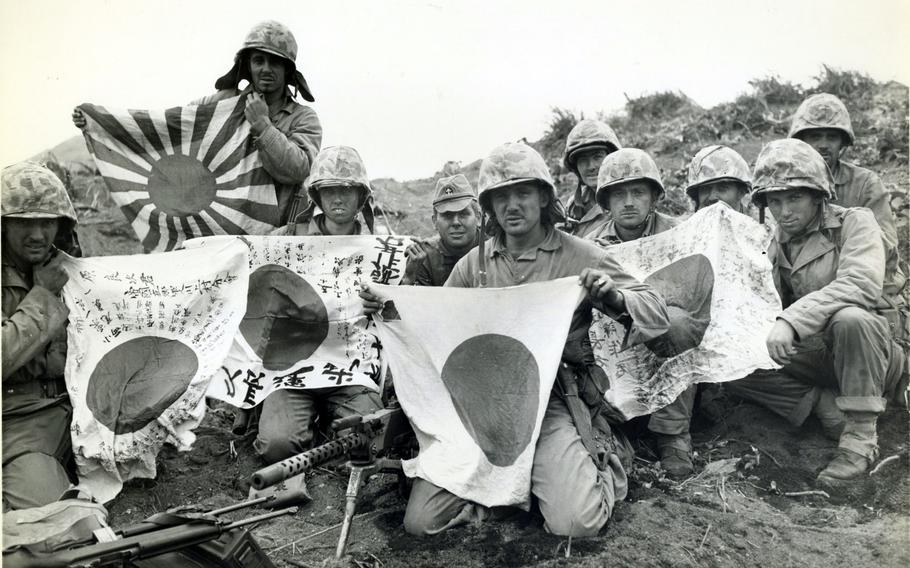
Marines pose with Japanese flags captured during the first few days of the fighting on Iwo Jima. (U.S. Marine Corps)
Charles Cram spent his first night on Iwo Jima alone in a foxhole, unsure of the time or what lay ahead.
“I didn’t know what time it was. It was dark, and I didn’t know anything about it,” Cram, 99, told Stars and Stripes by phone Thursday. “I wasn’t going to be able to get light in my foxhole. All I did was sit there, and I did a little bit of praying.”
Cram, a Navy corpsman with the 5th Marine Division, landed on the island with U.S. forces on Feb. 19, 1945. On the battle’s seventh day, a Japanese sniper shot him in the leg as he went outside the wire to check on a Marine lying on the ground.
“When I lifted his helmet off a little bit to the side, I could see that he had died,” he said.
Cram was evacuated to a hospital ship and later received the Silver Star, Bronze Star and Purple Heart for his service.
“I hated to think of the war, but it happened, and I did what I could to end the war,” he said. “And I hope some of the Japanese understood that.”
Cram and six other veterans are returning to Iwo Jima, now known as Iwo To, on Saturday for the 80th Reunion of Honor, which commemorates one of the war’s bloodiest battles. Around 170 people — but no WWII veterans — took part in last year’s ceremony on the island, the Marine Corps said at the time.
Defense Secretary Pete Hegseth is expected there Saturday as part of his first Indo-Pacific tour, Pentagon spokesman Sean Parnell confirmed Monday by email. Japanese Defense Minister Gen Nakatani told reporters Tuesday that he is making arrangements to attend, marking the first time cabinet officials from both countries will be present at the annual memorial.
The seven Marine Corps and Navy veterans, all older than 90, arrived on Guam late Tuesday.
The group includes Cram, 99, of San Diego, along with Patrick Zilliacus of Playa Del Rey, Calif.; Navy veteran Delmar Beard of Glendale, Ariz.; and former Marines Joe Caminiti of Bristol, Conn.; Ed Cavallini of Seaside, Calif.; Nils Mockler of Putnam Valley, N.Y.; and Frank Wright of Lodi, Calif.
Hegseth arrived in Hawaii on Monday and met with Adm. Samuel Paparo, head of U.S. Indo-Pacific Command. He also plans stops in Guam, the Philippines and Japan, according to a Pentagon news release.
Zilliacus, 98, was aboard the submarine USS Spot on March 17, 1945, weeks after the Iwo Jima battle began, when he experienced the scariest moment of his service.
The Spot had just sunk the Japanese cargo ship Nanking Maru near Iwo Jima in the East China Sea when it was nearly rammed by a W-17, an armed minelayer.
“It got so close I could tell that the Japanese sailors wore green uniforms with baseball bats,” he told Stars and Stripes by phone Thursday.
Although damaged, the Spot managed to knock out the minelayer’s forward gun with return fire. Later, the submarine had another close call in what is now the Taiwan Strait.
“We went through a minefield and felt the scraping of the cables of the mines,” Zilliacus said.
The Spot arrived at Saipan on March 23, 1945, to reload and resumed its patrol four days later, according to the Naval History and Heritage Command. The sub survived multiple depth-charge attacks during the war.
“I could describe it as being inside a steel barrel and having somebody beating it with sledgehammers,” Zilliacus said. “One time we lost the use of one engine because of severe depth charging.”
Approximately 70,000 Marines and several thousand Navy Seabees fought at Iwo Jima from Feb. 19 to March 26, 1945. U.S. forces sought control of the island as a staging area for a potential invasion of Japan. Roughly 7,000 Marines were killed and another 20,000 wounded in the fighting. Nearly 18,000 Japanese troops were killed.
Five years ago, about 230 U.S. veterans of Iwo Jima were still alive, according to Iwo Jima Association of America Director Raul Sifuentes. That number has since dwindled to about 150, he said.
On the 80th anniversary of the U.S. securing Iwo Jima, Zilliacus hopes people remember the sacrifices made.
“We must do everything we can to preserve this great nation of ours,” he said. “We are the greatest nation in the world, and we should be well-armed so that we can prevent war by being too dangerous to fight.”
Stars and Stripes reporter Keishi Koja contributed to this report.